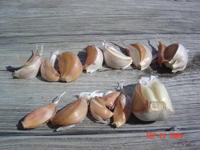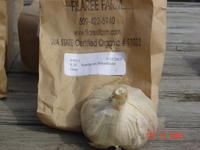 I stuck my thumb in the intersection and brought up only dust ( it is still so dry here ) so I used my dish soap bottle filled with water, and squirted water into each hole. It is a very handy tool.
I stuck my thumb in the intersection and brought up only dust ( it is still so dry here ) so I used my dish soap bottle filled with water, and squirted water into each hole. It is a very handy tool.I decided to plant Spanish Roja first. It is a Rocambole that is unfailingly my best garlic year
 after year, so why not plant lots of it. I began by opening my two Ag Fair entries, the biggest and best I had. Inside the first head, I found 13 cloves of which only 7 were plantable. One clove was rejected because it was too big and was a double clove. Double cloves send up two plants neither of which does particularly well. The other cloves were too small to plant. Size of clove is related to size of next year’s heads. In the end it took 6 heads of Spanish Roja to plant 40 cloves.
after year, so why not plant lots of it. I began by opening my two Ag Fair entries, the biggest and best I had. Inside the first head, I found 13 cloves of which only 7 were plantable. One clove was rejected because it was too big and was a double clove. Double cloves send up two plants neither of which does particularly well. The other cloves were too small to plant. Size of clove is related to size of next year’s heads. In the end it took 6 heads of Spanish Roja to plant 40 cloves. I only have one other Rocambole and that is a new one from Filaree Farm called Sandpoint. I opened the bag and to my surprise one quarter pound of seed garlic = one head, and a huge head it was! I was able to get the 10 cloves needed to give me one row of Sandpoint.
I only have one other Rocambole and that is a new one from Filaree Farm called Sandpoint. I opened the bag and to my surprise one quarter pound of seed garlic = one head, and a huge head it was! I was able to get the 10 cloves needed to give me one row of Sandpoint.Next I moved on to the Porcelains. The Porcelains are characterized by having only four, sometimes five, cloves per head all of which are suitable for planting. I began with Romanian Red.
This planted about half of a 4x8 raised bed. I always end up with more seed than I can plant. This leads to lots of loose cloves around that need to be used. Since I also have lots of loose basil around, I’m sure to make pesto. But the best use for loose garlic is bagna cauda. It involves bathing the garlic in wine and oil and then dipping either bread or artichokes (in Northern Italy they use cardoons)
Bagna Cauda
4 garlic BULBS with the cloves peeled
½ cup white wine
½ cup butter
¼ cup olive oil
2 oz. anchovy fillets coarsely chopped
Serve with cooked artichokes and other vegetables such as spring onions, new potatoes, radishes. Also need a loaf of crusty bread to catch the drippings.
Cut each garlic cloves into 5 or 6 thin lengthwise slices. Place the garlic in a medium saucepan, add the wine and set over low heat. Simmer 10 -15 minutes until the garlic begins to soften. Meanwhile melt the butter in a small saucepan and stir in the anchovies. Simmer 2-3 minutes until the anchovies begin to break up Add the olive oil, heat through and stir the mixture in to the garlic and wine. Simmer the sauce for 3-4 minutes and set aside.
Set a stand with a candle and place the heated sauce in the container. Surround with the vegetables and bread. Use the bread to catch the drippings from the vegetables

2 comments:
What a timely post for me. This year was the first year I actually had a garlic harvest. I just picked up a couple of heads of garlic at the local Kroger store. All in all they did pretty well. I planted them this spring and though I didn't realize the smaller cloves wouldn't get as big as the larger ones I was pleased to get any heads of any size. I would have had a harvest last year but a mishap with a riding mower (after laying my heads out in the lawn to dry a bit) gave the yard a lovely smell of garlic but no heads for me.
I just ordered some Silver Rose garlic and some shallots. Not sure how either will do here in Kentucky but I am crossing my fingers.
Which zone are you in? I am in 6a here in Norhtern Ky. I know someone else in Ky always plants their garlic around Thanksgiving. I am going to try planting some this fall and another batch in the spring and see which works best here. We don't really get winter until December though there are cold days and many frosts before then.
Kerry,
I'm in Zone 7. I am planting EARLY this year because I have to travel through much of October and November. I have planted as late as T-giving, but usually I put in the ground on Columbus Day Weekend.
The garlic likes to get a little root growth going before the winter. I have had better luck with the stiff necked Rocamboles than with the soft-necked braidable types. I have a link on my sidebar to Filaree Farms and to a book called Growing Great Garlic. Check them out
Leslie
Post a Comment